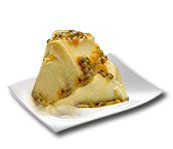 Full List of Fruits
Full List of Fruits  Giant Granadilla
Giant Granadilla
Giant Granadilla
Origin - They are known to originate from Tropical America.
Binomial name - Passiflora quadrangularis.
Appearance - Giant granadilla fruit appears to be in round or ovoid shape. The fruit has a tough peel with a waxy nature; the peel ranges in shade from dark purple to light yellow or pumpkin color.
Plenty of strain producing fruits of different size and quality are available. Some are insipid (Lacking in flavor or tasteless), whereas one of the superior flavors had originated at Cotabato.
Once P. macrocarpa was considered as a separate species with large fruits and good flavor but nowadays it hybridizes readily with smaller strains and there are intermediate types. Variegata is an ornamental form in which leaves are splashed with yellow.
| Vitamins per 100 g of Giant Granadilla | |
| Vitamin A | 1,652 IU |
| Vitamin C | 70.8 mg |
| Vitamin B3 (Niacin) |
0.378 mg |
| Minerals per 100 g of Giant Granadilla | |
| Calcium | 13.8 mg |
| Phosphorus | 17.1 mg |
| Iron | 0.80 mg |
Arils can be consumed without removing the seeds. The pulp (arils) yields a most delightful juice for cold drinks. The root of old vines are scorched and consumed in Jamaica as a substitute for yam.
- In tropics the fruit is used as an antiscorbutic (prevention or relief of scurvy) and stomachic.
- The flesh is set as a sedative to get relieve from the nervous headache, asthma, diarrhea, dysentery, neurasthenia and insomnia.
- The leaf decoction is a vermifuge (a medicine that expels intestinal worms) and is used for bathing skin afflictions (Pain or suffering).
- Leaf poultices are applied for liver complaints.
- Powdered root when mixed with oil is used as a soothing poultice.
The plant is rough-edged; its stems are four-angled, and the leaves are ovate or round-ovate in structure with 6 to 8 inches long in height.
The flower ranges to 3 inches in diameter which are white and purple in color. The fruits are oblong in shape, up to 10 inches in length.
Giant Granadilla belongs to the passion fruit species and is the largest fruit in this group. It is named after the square stem of the plant, which is a fast growing vine.
The fruit looks similar to a melon, which has a fragile skin and a thick layer of white flesh which tastes like a pear.Fruit is eaten fresh or used in drinks. The immature, green fruit is eaten as a vegetable. The pulp contains passiflorine, if consumed excessively, causes lethargy and somnolence.
Look for - Fruits that weigh heavy in size.1. Giant Granadilla Mouse

Ingredients:
- Unsweetened gelatin as required
- ¼ of water
- 1 ½ cups of Sweet Granadilla concentrated or frozen pulp, unsweetened
- 1 tbsp lime juice
- Whipping cream as required
- 7 egg whites
- ½ tbsp tartar cream
- Sugar as required
- 2-3 Sweet Giant Granadilla fruits, pulp and seeds(if needed)
Method:
- Take a pan and add Granadilla fruit juice, lime juice and sugar.
- Heat it until the sugar dissolves.
- Remove it and allow it to cool down completely.
- Pour the unsweetened gelatin over ╝ cup water in a bowl and allow it to soften for around 5 minutes.
- Place the bowl over a jar of water in simmer and blend until it dissolves completely.
- Add the above mixture to the passion fruit juice.
- Place the passion fruit and gelatin mixture in a bowl of cold water.
- Allow it cool down for 30 minutes by stirring it occasionally.
- Use an electric mixer to whip the cream until peaks are formed.
- Then use a spoon to mix in the passion fruit juice mixture.
- Then combine the egg whites and tartar cream in a large whipping bowl and mix until stiff peaks form.
- Using a beater beat 1/3 of the egg whites with the Granadilla fruit and whipped cream mix.
- Subsequently use a spatula to gently fold in the remaining stiff egg whites.
- Gently mix in the fresh passion fruit pulp and seeds.
- Place the mousse in individual molds, cover it and refrigerate for about 6-8 hours.
- Serve with whipped cream and a spoon of fresh Granadilla fruit pulp on top.



















